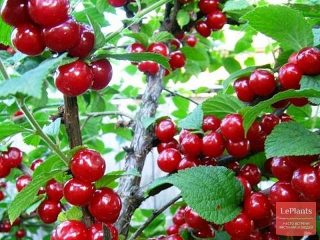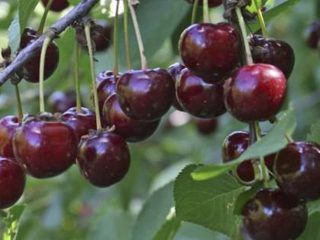Content
Cherry Nadezhda (duke) is a hybrid of cherries and sweet cherries, obtained as a result of breeding work by specialists at the Rossoshansky fruit and berry station. Since the mid-90s. of the last century, the Duke variety Nadezhda participates in state variety testing in the Central Black Earth region.
What does Nadezhda cherry look like?
The Nadezhda cherry-cherry hybrid tree is distinguished by its tall growth and wide spreading crown. The trunk is dark gray, almost black, with pronounced roughness and vertical cracking in young specimens.
Young shoots are green, with a brown tint, darken with age and acquire a reddish-brown color. The leaves are large, up to 12 cm long and about 5 cm wide, oval or ovoid, with a rounded base and a pointed apex.The outer surface is dark green, smooth, the inner surface is lighter in color and slightly pubescent.
Cherry variety Nadezhda forms inflorescences of 2–3 large (up to 40 mm in diameter) flowers. The opened buds are snow-white, but towards the end of flowering pink spots appear on the petals.

Cherry Nadezhda in full bloom looks very picturesque
This duke is best suited for cultivation in the Central and Southern regions of the country.
Height and dimensions of an adult tree
In adulthood, a tree of this variety can reach a height of 6 m. The crown is of medium density, broadly pyramidal or round, spreading. In adult specimens, its width can be 7 m.
Description of fruits
The description of the Duke variety Nadezhda contains the following characteristics of the fruit: the cherries are large, round in shape, slightly flattened on the sides. With a fruit size of 2.3–2.5 cm, its weight is 5.7–5.9 g.
The seed is small and can be easily separated from the pulp in well-ripened berries.
The skin is dense, dark red in color. The pulp is the same shade, medium-dense, uniform consistency. Red juice is released from the cut.
Taste rating based on tasting results: 4.5 points. The berry is sweet, with a slight sourness, no astringency.
Thanks to the dense skin, the berry does not crack, and the thick short stalk prevents the fruit from falling off.
Pollinators for Duke Nadezhda
Duke cherry Nadezhda is a self-sterile hybrid. This means that in order to set fruit in the area where it grows, it is necessary to plant cherries of other varieties. The best pollinators of Duke Nadezhda are cherries of the Lada, Kent and Black large varieties.
The hybrid is characterized by early flowering: in the southern parts of the country it occurs in the first ten days of May, in the central part - in mid-May.
Main characteristics of cherry Nadezhda
Cherry Nadezhda is a mid-season productive variety with good drought and frost resistance. The hybrid is immune to the most common diseases of cherries and requires basic care.
Drought resistance, frost resistance
Cherry Nadezhda shows good frost resistance, as well as resistance to temperature changes, but prolonged frosts can damage flower buds. The description of the Nadezhda cherry variety, as well as the reviews of gardeners who are well acquainted with this variety, contains information that the tree can withstand temperatures down to -30 ° C, while neither young shoots nor flower buds suffer from frost.
Like other cherry varieties, Duke Nadezhda is drought-resistant - the trees are watered several times during the season, but excess moisture is detrimental to them.
Productivity
In the description, Nadezhda cherry is characterized as a medium-ripening crop. When cultivated in the central part of Russia, the fruiting period begins in the first ten days of July; in the southern regions of the country, the harvest begins in the last ten days of June. Duke Nadezhda bears fruit 4–5 years after planting.
Experience shows that about 15 kg of fruit can be harvested from a young tree, a middle-aged cherry produces approximately 20 kg of berries, and the harvest from specimens that have reached 15 years of age can be up to 60 kg. These indicators correspond to a high level of productivity.
Cherry Nadezhda is a universal table variety. Its berries can be used both fresh and for making juice, compotes, jam, etc. The fruits are also widely used in cooking. The berries of this duke tolerate deep freezing well.
The fruits of the Nadezhda hybrid have good shelf life if the storage conditions for cherries are met, as well as high preservation of commercial qualities during transportation.

Nadezhda cherry berries have an attractive appearance
Advantages and disadvantages
Gardeners note the following advantages of Duke of Nadezhda:
- high stable yield;
- excellent taste;
- good keeping quality and transportability;
- unpretentiousness;
- frost resistance;
- immunity to cultural diseases.
The disadvantages of the variety often include the tall growth of trees, which complicates the care of plantings and harvesting, as well as the self-sterility of the duke.
Landing rules
Planting Nadezhda cherries does not require special skills. With the right choice of location and preliminary preparation of the soil, the seedlings take root well and produce growth the following year.
Recommended timing
Cherries can be planted both in spring and autumn. Many gardeners prefer autumn planting so that young trees can grow quickly next spring. In regions with cold winters, it is better to plant cherries in the spring to prevent unrooted seedlings from freezing.
Like other varieties of cherries, Duke Nadezhda is planted in mid-April or in the second ten days of October.
Site selection and soil preparation
When choosing a place for planting, it should be taken into account that cherries do not tolerate close groundwater. It is best to choose a dry, sunny area for it with neutral, medium-loamy or light soils.Alkaline soils are also suitable, but Duke Nadezhda cannot tolerate acidic substrates.
The soil mixture for seedlings is prepared in advance, about a month before the intended planting. Add the same amount of humus, 1 kg of wood ash, 1 tbsp each to the soil from the dug planting hole. l. with a pile of superphosphate and potassium chloride. If the soil is clayey, add river sand to it at the rate of 1 bucket of sand per 1 cherry seedling.
How to plant correctly
The procedure for planting cherries is quite simple:
- prepare pits with a depth of 40–50 cm and a diameter of 55–65 cm, the distance between which should be at least 3 m;
- seedlings are carefully inspected and damaged roots are removed;
- placed in a hole so that the root collar is at ground level. Cover with pre-prepared soil mixture;
- at a distance of about 30 cm from the trunk, make a small depression in a circle;
- water the seedlings with water heated in the sun at the rate of 2-3 buckets per hole;
- The tree trunk circle is mulched with humus or compost.

The root collar of the seedling should not be buried
Features of care
Duke Nadezhda, like other cherry varieties and hybrids, is not demanding in terms of care. Mandatory measures include: regular watering, fertilizing, pruning, preparation for winter and disease prevention. Cherry also responds well to loosening.
Watering and fertilizing schedule
Cherry Nadezhda tolerates drought well and usually does not require more than three waterings per season.
The first watering is carried out after flowering has completed, the second - when the fruits ripen, the third - before winter, when the leaves fall.
If the soil for planting has been properly prepared, young trees do not need to be fertilized for the first 2–3 years. In the future, fertilizing is carried out during the autumn digging of the soil. Potassium fertilizers are applied at a rate of 70 g and phosphorus fertilizers in an amount of approximately 200 g per plant. In spring, the soil around the cherry tree is fertilized with nitrogen fertilizers, the application rate of which is about 50 g per tree.
Trimming
2 years after planting, the tree crown begins to form. To do this, at the very beginning of spring, last year's growths are cut off by a third of their length. Cherries also need sanitary pruning. Broken, dry, frozen and diseased branches should be removed in a timely manner.
Preparing for winter
Thanks to its frost resistance, Nadezhda cherry tolerates winter well and does not need shelter. In late autumn, only young, recently planted trees are hilled. If there is a danger of severe frosts, the soil around the trunks is mulched. In other cases, plantings are watered abundantly after the end of leaf fall.

Mulching not only protects the root system from frost, but also retains moisture and prevents the growth of weeds
Diseases and pests
Duke cherry Nadezhda has good resistance to crop diseases. The most common and dangerous diseases are coccomycosis and moniliosis, to which cherries of this variety are also immune.
Rodents also pose no threat to cherries, since the trees have bitter bark.
Conclusion
Nadezhda cherry is excellent for growing not only in the south of the country, but also in the middle zone, it requires minimal care and is resistant to diseases. At the same time, it has excellent taste and consistently high yield. The description of the Nadezhda variety, numerous photos of fruits and trees, as well as reviews of this duke indicate its popularity among Russian gardeners.








